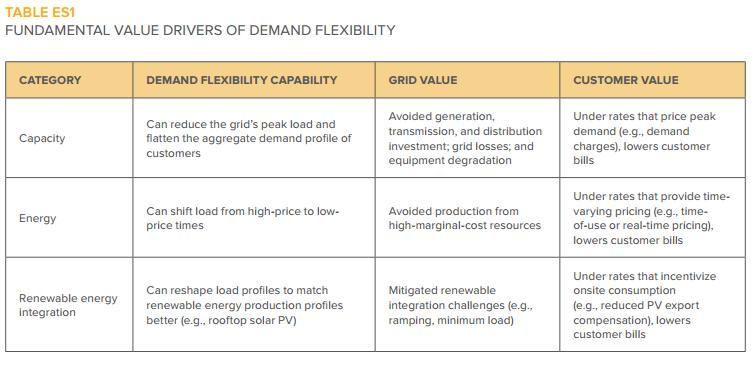Editor’s note: This executive summary comes from a document of the same name published by the Rocky Mountain Institute. For the full report, pick here: http://www.rmi.org/electricity_demand_flexibility
Electric utilities in the United States plan to invest an estimated $1+ trillion in traditional grid infrastructure— generation, transmission, and distribution—over the next 15 years, or about $50–80 billion per year, correcting years of underinvestment. However, official forecasts project slowing electricity sales growth in the same period (less than 1% per year), coming on the heels of nearly a decade of flat or declining electricity sales nationwide. This is likely to lead to increasing retail electricity prices for customers over the same period. Meanwhile, those customers enjoy a growing menu of increasingly cost-effective, behind-the-meter, distributed energy resource (DER) options that provide choice in how much and when to consume and even generate electricity. These dual trends and how customers might respond to them—rising prices for retail grid electricity and falling costs for DER alternatives that complement (or in extreme cases even supplant) the grid—has caused considerable electricity industry unrest. It also creates a potential for overinvestment in and duplication of resources on both sides of the meter. Yet utility and customer investments on both sides of the meter are based on the view that demand profiles are largely inflexible; flexibility must come solely from the supply side. Now, a new kind of resource makes the demand side highly flexible too. Demand flexibility (DF) evolves and expands the capability behind traditional demand response programs. DF allows demand to respond continuously to changing market conditions through price signals or other mechanisms. DF is proving a grossly underused opportunity to buffer the dynamic balance between supply and demand.  When implemented, DF can create quantifiable value (e.g., bill savings, deferred infrastructure upgrades) for both customers and the grid. Here, we analyze demand flexibility’s economic opportunity. In the residential sector alone, widespread implementation of demand flexibility can save 10 to 15% of potential grid costs, and customers can cut their electric bills 10–40% with rates and technologies that exist today. Roughly 65 million customers already have potentially appropriate opt-in rates available, so the aggregate market is large and will only grow with further rollout of granular retail pricing.
When implemented, DF can create quantifiable value (e.g., bill savings, deferred infrastructure upgrades) for both customers and the grid. Here, we analyze demand flexibility’s economic opportunity. In the residential sector alone, widespread implementation of demand flexibility can save 10 to 15% of potential grid costs, and customers can cut their electric bills 10–40% with rates and technologies that exist today. Roughly 65 million customers already have potentially appropriate opt-in rates available, so the aggregate market is large and will only grow with further rollout of granular retail pricing.
Demand flexibility defined
Demand flexibility uses communication and control technology to shift electricity use across hours of the day while delivering end-use services (e.g., air conditioning, domestic hot water, electric vehicle charging) at the same or better quality but lower cost. It does this by applying automatic control to reshape a customer’s demand profile continuously in ways that either are invisible to or minimally affect the customer, and by leveraging more-granular rate structures that monetize demand flexibility’s capability to reduce costs for both customers and the grid. Importantly, demand flexibility need not complicate or compromise customer experience. Technologies and business models exist today to shift load seamlessly while maintaining or even improving the quality, simplicity, choice, and value of energy services to customers.
The emerging value of flexiwatts: The broader opportunity for DERs to lower grid costs
Electric loads that demand flexibility shifts in time can be called flexiwatts—watts of demand that can be moved across the hours of a day or night according to economic or other signals. Importantly, flexiwatts can be used to provide a variety of grid services. Customers have an increasing range of choices to meet their demand for electrical services beyond simply purchasing kilowatt-hours from the grid at the moment of consumption. Now they can also choose to generate their own electricity through distributed generation, use less electricity more productively (more-efficient end-use or negawatts), or shift the timing of consumption through demand flexibility. All four options need to be evaluated holistically to minimize cost and maximize value for both customers and the grid.
Filed Under: News




